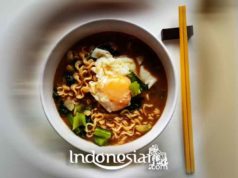Indonesia has delicious culinary delights that use processed rice. One of them is the tutug oncom rice from Tasikmalaya. The traditional cuisine from the hometown of badminton legend Susy Susanti is a dish of warm rice mixed with grilled oncom.
In the local language tutug means “pounded”. Therefore, tutug oncom rice is rice mixed with mashed oncom. TO rice, as this food is usually called, must be served warm. The combination of savory, salty and fluffier flavors is felt when this rice is chewed in the mouth. Don’t forget to give sambal goang, which is green chili sauce mixed with a little salt and seasonings on TO rice. The salty oncom fragments seemed to explode on the tongue, along with the savory taste of fried onion-covered rice combined with sambal goang.
Not only the sambal goang that accompanies the delicious rice TO. You can also add complementary side dishes, such as omelette, salted fish, fried chicken, and fresh vegetables in the form of cucumber. A sprinkling of fried onions must be served so that it is more appetizing and makes the rice more fragrant. Not a few also add it with cipe, which stands for aci tempeh or fried tempeh. Aci is the term for ‘starch’ in Sundanese.
To bring delicious and tasty TO rice requires a slightly complicated process. Observer of Sundanese cuisine Andang Firdaus explained that before being mixed with rice, oncom, which was originally shaped like a block like tempeh, had to be ground into slightly coarse granules and dried in the sun for a day. After that, the dry oncom is sprinkled with flavorings such as kencur, red onion, garlic, a little sugar, and salt to taste and then dried again. Then the oncom is cooked without oil or roasted until cooked.
The pattern of serving TO rice is done directly in warm conditions. The processed oncom that has been brewed must be directly combined with rice. That’s because tutug oncom cannot be consumed for more than one day, let alone stored in the refrigerator or freezer. The reason is, excessive fermentation factors and side effects of poisoning for those who consume.
Initially, Nasi TO was a daily food menu for the lower class people in Sundanese land. Oncom is authentic Sundanese food made from soybeans and sold at very affordable prices. Therefore, oncom was also used as a side dish for rice by the lower classes in the 1940s.
Especially in that era, the price of basic community commodities, including rice, was almost beyond the reach of the lower class. They also outsmarted it by mixing oncom and rice to make it look denser and more abundant.
Its delicious taste makes this food gradually rise in class and is liked by various circles of society. TO is no longer consumed in a limited manner by certain circles. That is why, TO rice is now not only sold in simple stalls or semi-permanent stalls.
A number of culinary service entrepreneurs in Tasik are increasingly excited to build a special restaurant for Nasi TO. Not a few of the visitors came with their families to drive four-wheeled vehicles. This can be seen in the area starting from Jl Dadaha, not far from the Susy Susanti Sports Center (GOR), Jl Cikalang Girang, and also on Jl Ampera, Tasikmalaya City.
If it has been served with complementary menus such as fried chicken, fried tofu, fried tempeh, tofu or bacem tempeh, omelet, salted fish plus sambal goang and fresh vegetables, it is no longer worthy of being called the food of the lower class. Per portion can be priced between IDR 20,000 to IDR 35,000. However, this traditional culinary can still be enjoyed for no more than Rp.10,000 to Rp.15,000 with a choice of simpler side dishes. Come on, get interesting culinary information from Indonesiar.com and visit Indonesia.

































